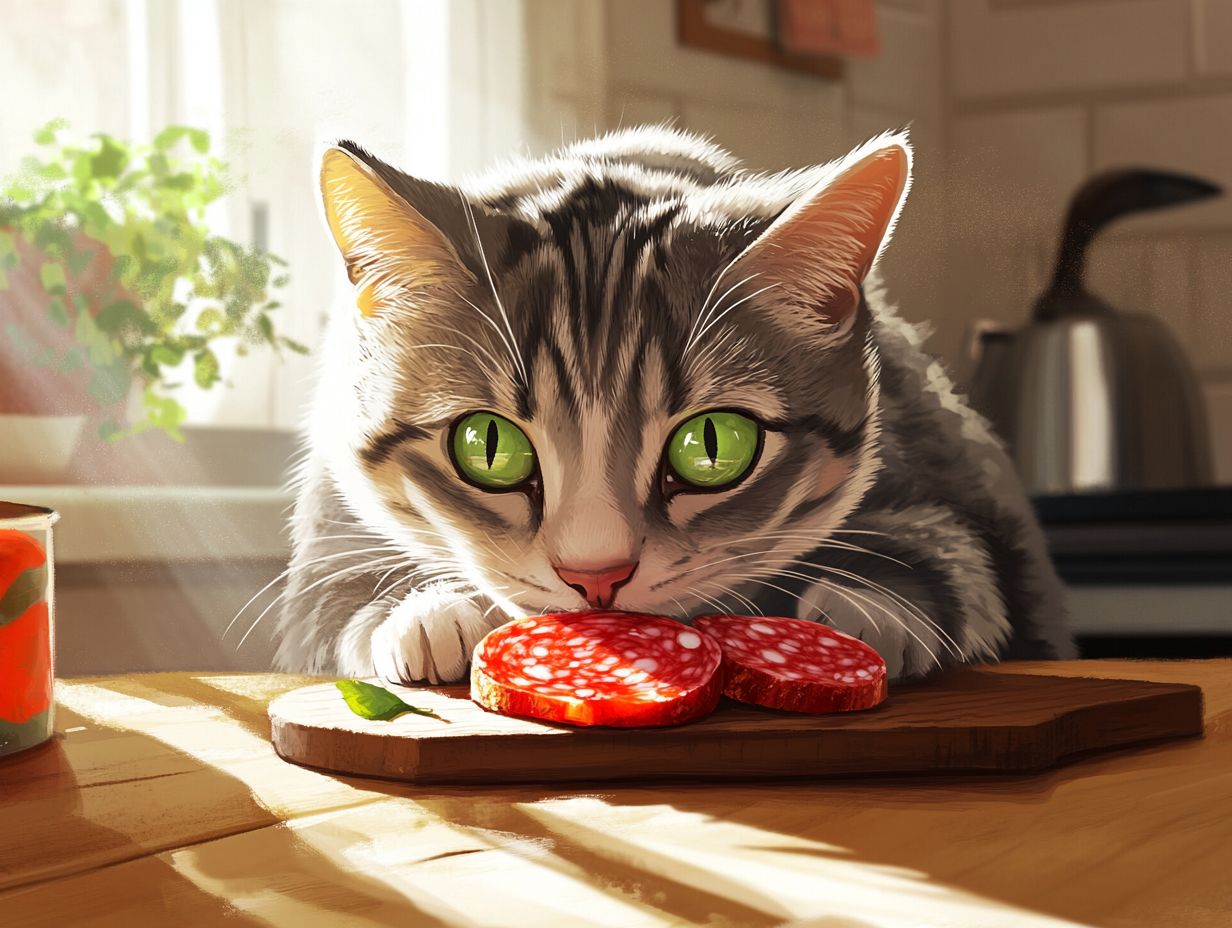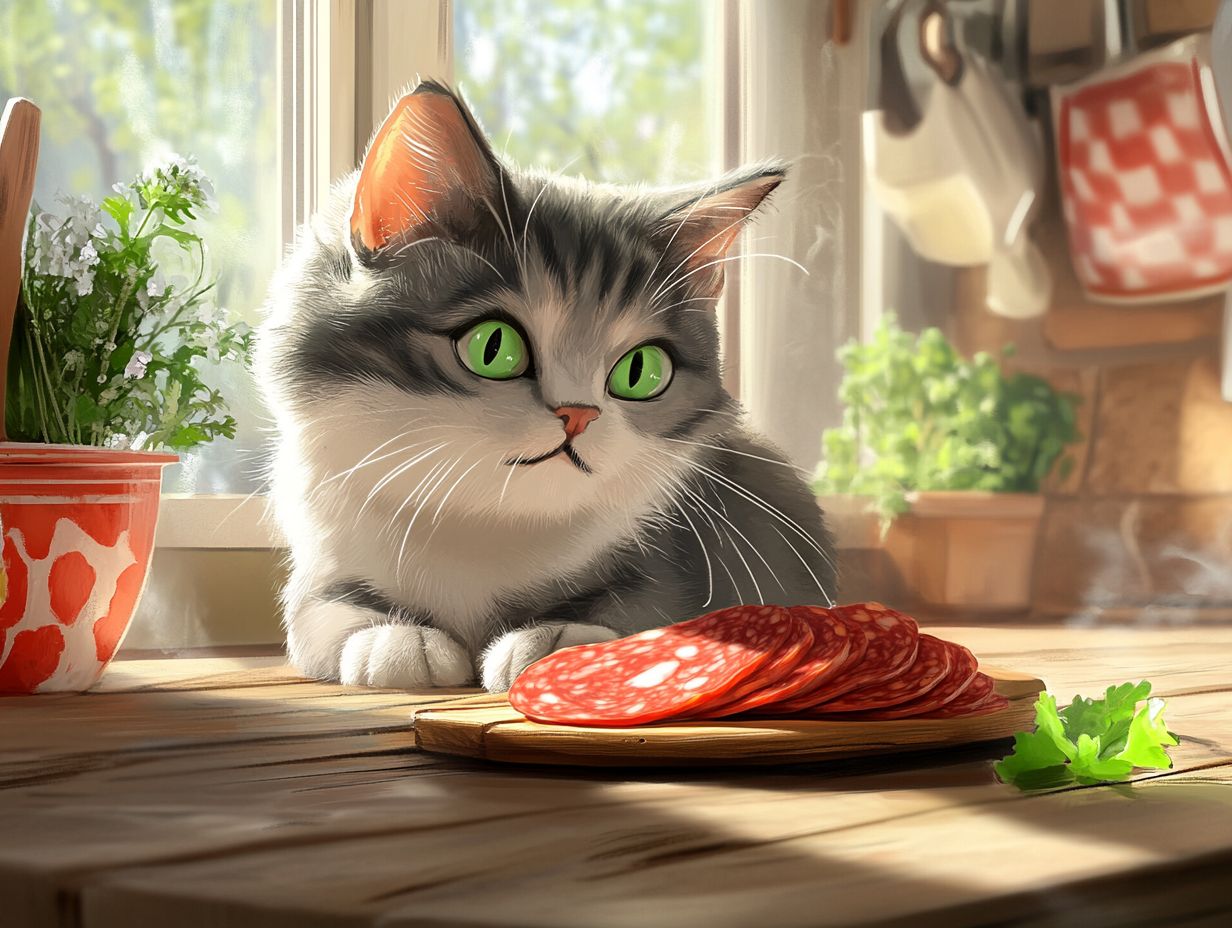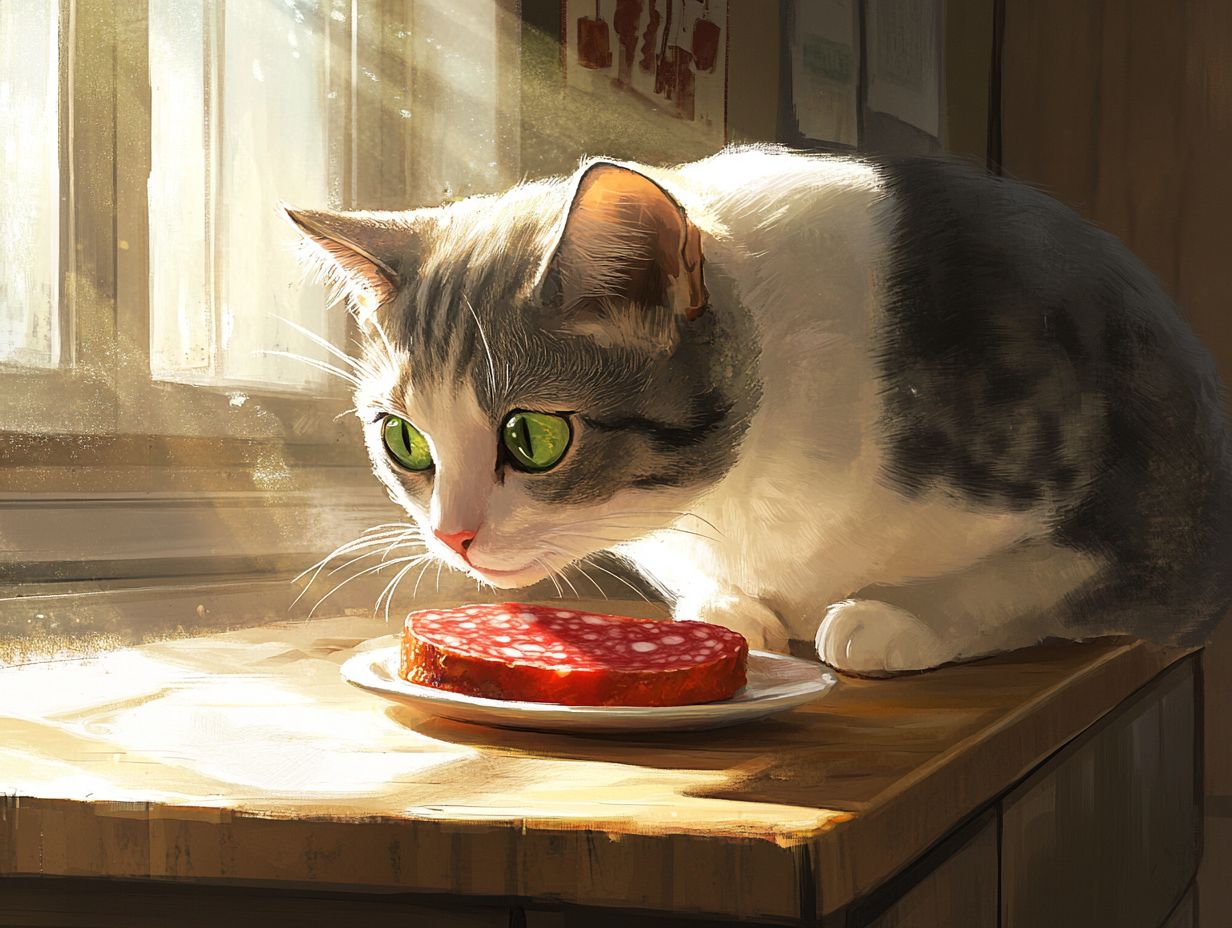Is salami safe for cats? Understanding the dietary needs of our feline friends is crucial for maintaining their health and happiness. Many cat owners, including those who consult experts like Sara Ochoa, DVM, often wonder about various human foods, particularly salami and its varieties like pepperoni, hard salami, and cacciatore.
This article explores the safety of salami for cats, weighing potential risks and benefits, and offering healthier alternatives.
It also discusses how to introduce new foods, signs of allergic reactions to ingredients such as garlic and onions, and provides final recommendations to ensure your cat’s diet remains balanced and nutritious.
Curious about your kitty’s culinary options? Read on!
Key Takeaways:

- Cats primarily need meat-based diets, rich in protein and taurine.
- While cats can consume salami, it is generally not recommended due to its high fat and sodium content and lack of essential nutrients.
- Healthier and safer treats for cats include cooked lean meats and certain fruits and vegetables.
Understanding a Cat’s Diet
Cats primarily need meat-based diets for optimal health. Protein is essential for maintaining muscle mass, supporting their immune system, and providing energy. Key nutrients such as taurine are crucial for heart and eye health. However, certain foods can be harmful and may lead to health risks such as dehydration or other serious conditions.
- Cats require a balanced diet rich in protein and taurine.
- They should avoid foods high in fat and salt.
- Protein serves as the main source of energy and supports various bodily functions.
- Taurine, found in meat, must be included in a cat’s diet for overall health.
Cat owners should be cautious about incorporating processed meats into their pets’ diets, as these foods often contain preservatives, excessive salt, and unhealthy fats that can lead to obesity and other health issues. A diet low in salt and fat helps cats maintain a healthier weight and reduces their risk of developing hypertension and pancreatitis.
Can Cats Eat Salami?
Salami is a type of processed meat that many pet owners question in terms of its safety for cats, particularly due to its high salt and fat content, which could pose health risks if consumed regularly.
While cats often enjoy the taste of salami, careful consideration is necessary when feeding such treats. Regular consumption could lead to complications, including sodium-related issues and potential dangers like salmonella poisoning.
Benefits of Salami
When given in moderation, salami can provide positive experiences in terms of taste and a protein boost.
Many cat owners enjoy offering salami as a tasty snack for their pets. However, it is crucial to remain aware of the associated risks.
Risks of Salami
- High sodium content poses health risks, especially for cats prone to dehydration or kidney damage.
- Potential for salmonella contamination means salami should only be given to cats if it is properly prepared and served.
- Regular consumption can lead to obesity and other health issues.
Alternatives to Salami for Cats
There are numerous healthy alternatives to salami that can serve as treats for cats, fulfilling their protein and taurine requirements. Options include salmon or specially formulated cat treats.
Summary
In summary, salami is generally not recommended for cats due to its high sodium content and potential health risks. Always consider healthier alternatives and consult your veterinarian before introducing new foods to your cat’s diet.
Conclusion
Always consult your veterinarian before introducing new foods to your cat’s diet to ensure their health and well-being.
Healthy and Safe Treats for Cats
When looking for safe and healthy treats for cats, options like salmon, chicken, and turkey are excellent choices. Salmon is a great source of protein and essential fatty acids, making it a suitable alternative to high-salt processed meats like salami. High-protein treats align with a cat’s natural hunting instincts while promoting muscle growth and a strong immune system.
Treats rich in taurine—an essential amino acid for cats—such as small pieces of cooked chicken or turkey significantly enhance a cat’s overall health. Offering tuna as an occasional treat can also be a tasty option; it is rich in omega-3 fatty acids, which contribute to healthy skin and a shiny coat.
Freeze-dried or gently cooked fish treats retain both flavor and nutrients, providing a delicious and safe option. Incorporating variety through healthy cat treat recipes is a great way to indulge your pet while ensuring they receive proper nutrition.
Tip: Limit treats to 10% of your cat’s daily caloric intake to maintain a healthy diet.
How to Introduce Salami to Your Cat
Salami can be offered to cats, but it should be given in moderation and with caution. Ensuring appropriate portions and taking necessary precautions minimizes the risks associated with excessive sodium and fat intake. It is important to pay attention to how your cat reacts to dietary changes.
Health Risks of Feeding Salami to Cats
The primary long-term concerns associated with processed meats include obesity and heart disease due to their excessive sodium and fat content. Feeding salami to cats is acceptable as a rare treat; however, it should not be included in a cat’s regular diet.
Proper Portions and Precautions

Maintain proper portion sizes to mitigate health risks associated with high salt and fat content. A small slice or a tiny amount is usually sufficient to satisfy a cat’s curiosity without upsetting its digestive system. For example, limit to half a slice of salami or 1/4 teaspoon for smaller cats. A treat should not exceed one teaspoon of cooked chicken per 10 pounds of body weight.
Pet owners should monitor their cats for any adverse reactions. Consult a veterinarian for guidance on introducing new foods to your cat’s diet.
Signs of an Allergic Reaction
It is essential for pet owners to recognize the signs of allergic reactions in cats, as certain food ingredients—especially those containing garlic or onions—can be toxic.
Identifying and Addressing Symptoms
Symptoms of allergic reactions in cats should be monitored closely. Common symptoms include: Can Cats Eat Salami? Is It Safe for Cats?
- Excessive scratching
- Swelling around the face and paws
- Vomiting
- Diarrhea
- Difficulty breathing
These symptoms may arise if a cat has ingested something potentially toxic. Remove the offending item and observe your cat closely. If symptoms do not subside or worsen, veterinary intervention is necessary.
Final Thoughts and Recommendations
Salami poses health risks due to its high fat and sodium content, which can lead to obesity and heart disease. Prioritize nutrition when selecting treats for cats, and consider safer alternatives such as:
- Cooked chicken
- Fish
- Specially formulated cat treats that contain the right nutrients without unnecessary additives
Always consult a veterinarian before introducing new foods into your cat’s diet.
One common question among cat owners is: “Can cats eat salami?” The answer is clear: Salami is not safe for cats. This popular human food can pose several health risks due to its high fat, salt, and preservative content, which does not meet the nutritional needs of our feline friends.
Frequently Asked Questions

Can cats eat salami?
No, salami is not safe for cats.
Is salami safe for cats?
No, salami can cause digestive issues and other health problems in cats.
Why is salami not safe for cats?
Salami is high in fat, salt, and preservatives, which can lead to symptoms like vomiting and diarrhea, and long-term health issues such as obesity and hypertension.
Can a small amount of salami be given to cats as a treat?
No, even a small amount of salami can be harmful and should not be given as a treat.
What should I do if my cat accidentally ate salami?
If your cat has consumed salami, especially varieties like Genoa salami that may contain garlic or onion, monitor them closely for symptoms like vomiting or lethargy. It’s best to contact your veterinarian, such as Sara Ochoa, DVM, for advice.
What are some safe alternatives to salami for cats?
Instead of salami, consider these safe treats:
- Cooked chicken: a great protein source.
- Plain canned tuna: an occasional treat that cats love.
- Small amounts of cooked fish: provides essential fatty acids.
Guidelines for Safe Feeding
When offering treats to your cat, follow these guidelines:
- Limit treats to no more than 10% of your cat’s daily caloric intake.
- Avoid foods high in fat, salt, and preservatives.
- Always consult your veterinarian before introducing new foods.
By prioritizing your cat’s health and avoiding unsafe foods like salami, you can ensure they live a happy and healthy life. Always consult with a veterinarian for the best dietary practices.